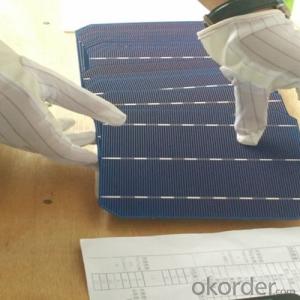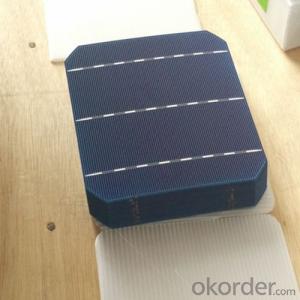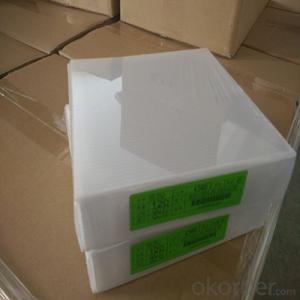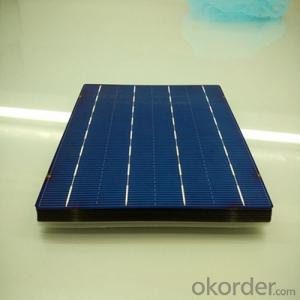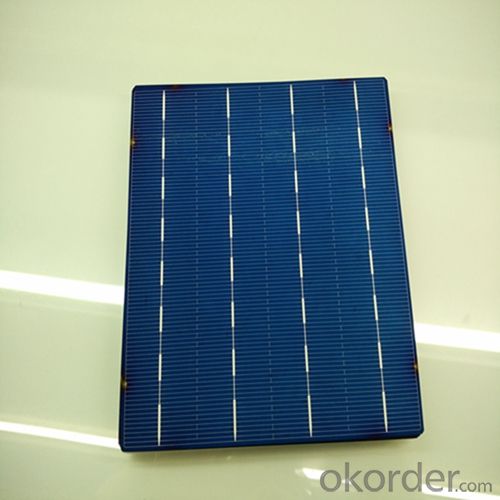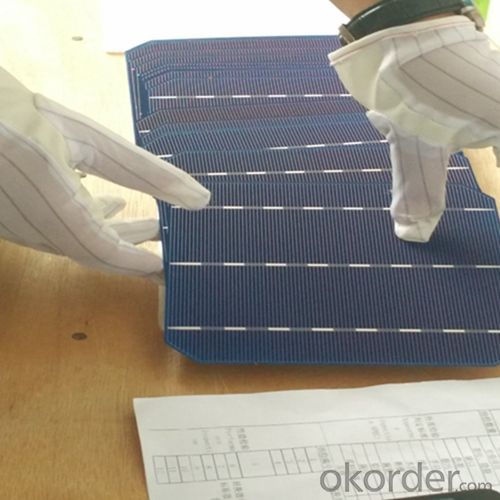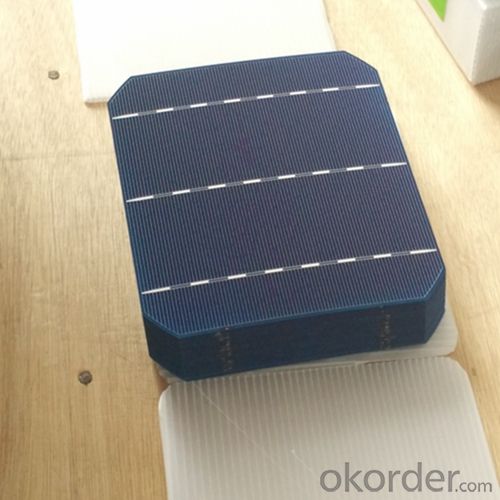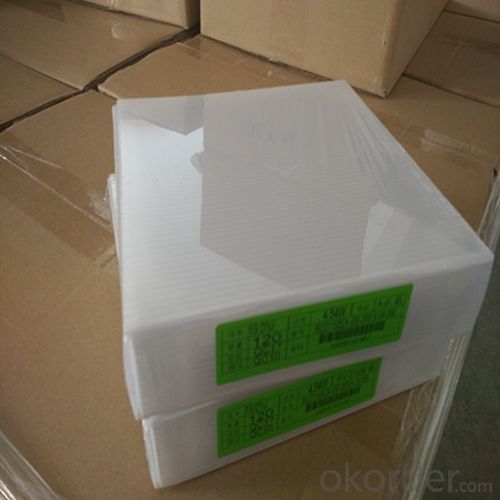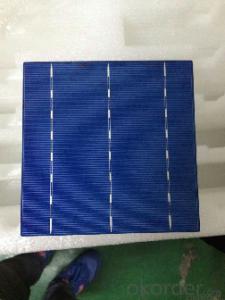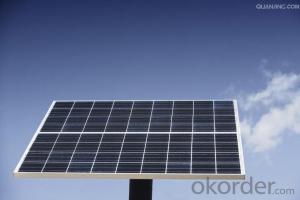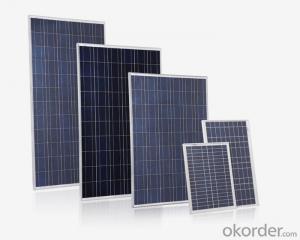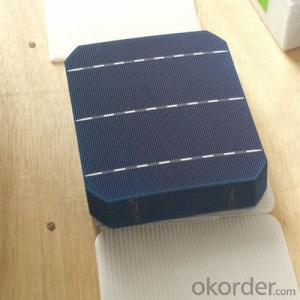Printed Organic Solar Cells - Poly 156x156mm2 Class A3 Solar Cells
- Loading Port:
- Shanghai
- Payment Terms:
- TT OR LC
- Min Order Qty:
- 6000 watt
- Supply Capability:
- 6000000 watt/month
OKorder Service Pledge
OKorder Financial Service
You Might Also Like
The operation of a photovoltaic (PV) cell requires 3 basic attributes:
The absorption of light, generating either electron-hole pairs or excitons.
The separation of charge carriers of opposite types.
The separate extraction of those carriers to an external circuit.
In contrast, a solar thermal collector supplies heat by absorbing sunlight, for the purpose of either direct heating or indirect electrical power generation from heat. A "photoelectrolytic cell" (photoelectrochemical cell), on the other hand, refers either to a type of photovoltaic cell (like that developed by Edmond Becquerel and modern dye-sensitized solar cells), or to a device that splits water directly into hydrogen and oxygen using only solar illumination.Characteristic of Mono 156X156MM2 Solar Cells
You are gaining energy independence - add battery backup power for even greater energy security
The cost of electricity is only going to rise – insure against that rising cost
Adaptive cells change their absorption/reflection characteristics depending to respond to environmental conditions. An adaptive material responds to the intensity and angle of incident light. At the part of the cell where the light is most intense, the cell surface changes from reflective to adaptive, allowing the light to penetrate the cell. The other parts of the cell remain reflective increasing the retention of the absorbed light within the cell.[67]
In 2014 a system that combined an adaptive surface with a glass substrate that redirect the absorbed to a light absorber on the edges of the sheet. The system also included an array of fixed lenses/mirrors to concentrate light onto the adaptive surface. As the day continues, the concentrated light moves along the surface of the cell. That surface switches from reflective to adaptive when the light is most concentrated and back to reflective after the light moves along
Mechanical data and design
Format | 156mm x 156mm±0.5mm |
Thickness | 210μm±40μm |
Front(-) | 1.5mm bus bar (silver),blue anti-reflection coating (silicon nitride) |
Back (+) | 2.5mm wide soldering pads (sliver) back surface field (aluminium) |
Temperature Coefficient of Cells
Voc. Temp.coef.%/K | -0.35% |
Isc. Temp.coef .%/K | +0.024%/K |
Pm.Temp.coef. %/K | -0.47%/K |
Electrical Characteristic
Effiency(%) | Pmpp(W) | Umpp(V) | Impp(A) | Uoc(V) | Isc(A) | FF(%) |
18.35 | 4.384 | 0.526 | 8.333 | 0.63 | 8.877 | 78.39% |
18.20 | 4.349 | 0.526 | 8.263 | 0.63 | 8.789 | 78.54% |
18.05 | 4.313 | 0.525 | 8.216 | 0.63 | 8.741 | 78.32% |
17.90 | 4.277 | 0.524 | 8.161 | 0.625 | 8.713 | 78.04% |
17.75 | 4.241 | 0.523 | 8.116 | 0.625 | 8.678 | 77.70% |
17.60 | 4.206 | 0.521 | 8.073 | 0.625 | 8.657 | 77.36% |
17.45 | 4.170 | 0.519 | 8.039 | 0.625 | 8.633 | 76.92% |
17.30 | 4.134 | 0.517 | 8.004 | 0.625 | 8.622 | 76.59% |
17.15 | 4.096 | 0.516 | 7.938 | 0.625 | 8.537 | 76.80% |
17.00 | 4.062 | 0.512 | 7.933 | 0.625 | 8.531 | 76.18% |
16.75 | 4.002 | 0.511 | 7.828 | 0.625 | 8.499 | 75.34% |
16.50 | 3.940 | 0.510 | 7.731 | 0.625 | 8.484 | 74.36% |
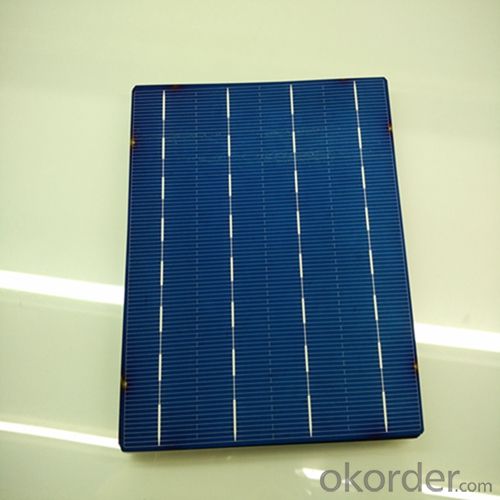
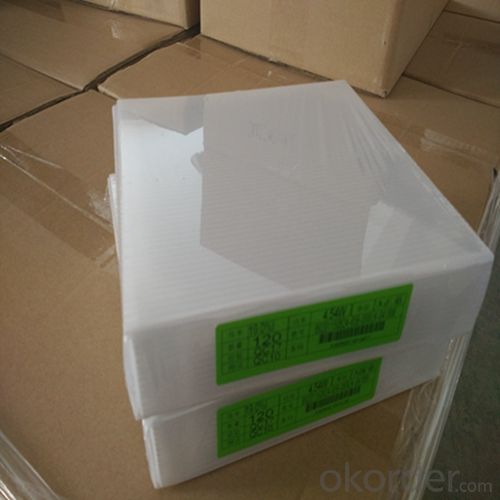
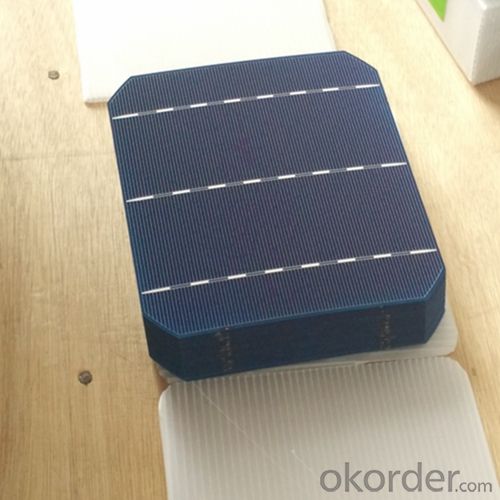
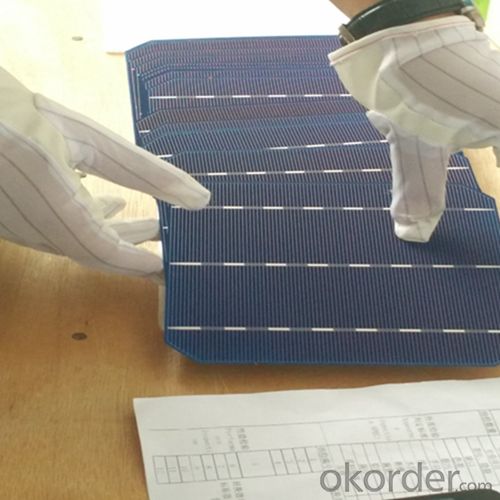
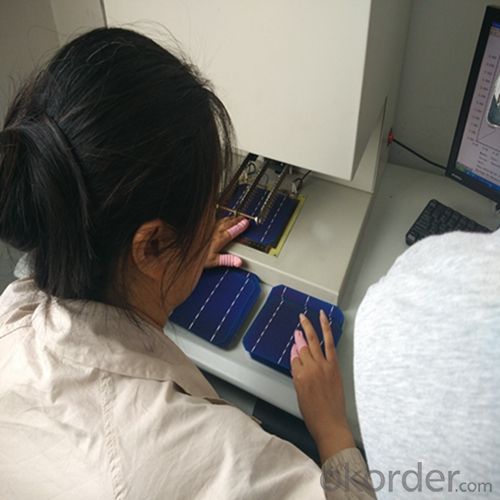 FAQ
FAQ
Q: What price for each watt?
A: It depends on the quantity, delivery date and payment terms, generally Large Quantity and Low Price
Q: What is your size for each module? Can you tell me the Parameter of your module?
A: We have different series of panels in different output, both c-Si and a-Si. Please take the specification sheet for your reference.
Q: What is your size for each module? Can you tell me the Parameter of your module?
A: We have different series of panels in different output, both c-Si and a-Si. Please take the specification sheet for your reference.
- Q: How can I explain to my 10 year old daughter what solar cells are?
- Solar cells are the cell that can collect the solar energy from nature.
- Q: Can solar cells be used in military vehicles?
- Yes, solar cells can be used in military vehicles. They can provide an alternative source of energy to power various systems and equipment, reducing reliance on traditional fuel sources and enabling greater operational flexibility and sustainability. Additionally, solar cells can help extend the range and endurance of military vehicles in remote or austere environments where access to conventional fuel supplies may be limited.
- Q: How do solar cells affect air pollution?
- Solar cells help reduce air pollution by generating clean, renewable energy from the sun. Unlike traditional fossil fuel power plants that release harmful pollutants like carbon dioxide, sulfur dioxide, and nitrogen oxides into the air, solar cells produce electricity without any emissions. By replacing fossil fuels with solar energy, we can decrease the amount of air pollution, mitigate climate change, and improve overall air quality.
- Q: Many people said the usage of solar cell can reduce the cost overall, but does anyone agree with me that it actually cost a lot to operate a solar cell system?
- It cost less in terms of the energy waste.
- Q: How do solar cells perform in regions with high levels of humidity and rainfall?
- Solar cells can still perform well in regions with high levels of humidity and rainfall. While excessive moisture can temporarily reduce their efficiency, modern solar cell designs are built to withstand such conditions. Additionally, rainwater can actually help to clean the surface of the solar panels, improving their performance in the long run.
- Q: Can solar cells be used in hotels?
- Yes, solar cells can definitely be used in hotels. Solar panels can be installed on the rooftops or surrounding areas of hotels to harness solar energy and generate electricity. This renewable energy source can help hotels reduce their reliance on traditional power grids, lower their carbon footprint, and save on electricity costs in the long run. Additionally, hotels can also utilize solar power for heating water, lighting outdoor spaces, or charging electric vehicles, further enhancing their sustainability initiatives.
- Q: How do solar cells impact local economies?
- Solar cells can have a positive impact on local economies in several ways. Firstly, the installation and maintenance of solar energy systems create job opportunities, contributing to local employment rates. Additionally, solar energy reduces the dependence on fossil fuels, which can lead to a decrease in energy costs for businesses and households, thereby stimulating economic growth. Moreover, the use of solar cells promotes energy independence, reducing the need for importing energy and keeping money within the local economy. Overall, solar cells can foster job creation, cost savings, and energy autonomy, all of which contribute to a stronger and more sustainable local economy.
- Q: How can I calculate the cost of using solar cells if I put a fully-functional solar system in my house?
- Sunrun solar lets you get started for as little as $0 down, but to install it, it will cost you a lot.
- Q: Why should the solar cells be laserized?
- Extended reading: Through the practice of testing and manufacturers, Tuopu photoelectric laser etching technology summary, the results of the current solar photovoltaic industry using laser etching scribing technology P1 level using narrow pulse infrared nano-laser is the most ideal,
- Q: Is the Solar Power Photovoltaic Cells the same as PV cells modules?
- According to the size and scale of the photovoltaic power station, the PV modules can be composed of various sizes and different arrays.
Send your message to us
Printed Organic Solar Cells - Poly 156x156mm2 Class A3 Solar Cells
- Loading Port:
- Shanghai
- Payment Terms:
- TT OR LC
- Min Order Qty:
- 6000 watt
- Supply Capability:
- 6000000 watt/month
OKorder Service Pledge
OKorder Financial Service
Similar products
Hot products
Hot Searches
Related keywords

